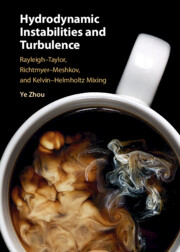 Hydrodynamic Instabilities and Turbulence
Hydrodynamic Instabilities and Turbulence Book contents
- Frontmatter
- Dedication
- Contents
- Preface
- Acknowledgments
- Part 1 Fundamentals
- 1 A first glimpse of Rayleigh–Taylor, Richtmyer–Meshkov, and Kelvin–Helmholtz instabilities
- 2 The linear stage for a singlemode
- 3 The nonlinear stage for a singlemode
- 4 Multimode instabilities: Linear and nonlinear regimes
- 5 Global features from the lens of integrated mixingmeasurements
- 6 Internal dynamics from the lens of statistical mixingmeasurements
- 7 Elementary aspects of turbulent flows
- 8 Transition to turbulence
- Part 2 Hydrodynamics of Complex Flows
- Part 3 From the Microscopic to Cosmic Scales
- References
- Index
7 - Elementary aspects of turbulent flows
from Part 1 - Fundamentals
- Frontmatter
- Dedication
- Contents
- Preface
- Acknowledgments
- Part 1 Fundamentals
- 1 A first glimpse of Rayleigh–Taylor, Richtmyer–Meshkov, and Kelvin–Helmholtz instabilities
- 2 The linear stage for a singlemode
- 3 The nonlinear stage for a singlemode
- 4 Multimode instabilities: Linear and nonlinear regimes
- 5 Global features from the lens of integrated mixingmeasurements
- 6 Internal dynamics from the lens of statistical mixingmeasurements
- 7 Elementary aspects of turbulent flows
- 8 Transition to turbulence
- Part 2 Hydrodynamics of Complex Flows
- Part 3 From the Microscopic to Cosmic Scales
- References
- Index
Summary
Turbulent flow is a notoriously difficult topic in its own right because it is a truly multi-scale problem with strong nonlinearities. However, in this chapter, I will provide a framework for the key concepts, statistical measurements, and implications for the mixing process, so that the reader can better understand this issue. Both the classic engineering treatment of turbulence as well as the modern statistical closure theories will be introduced and brought together to show the reader how they can be synthesized to describe turbulence mixing induced by hydrodynamic instability driven flows. Some of the key concepts that I will elaborate on include energy transfer and interacting scales. The energy spectrum, and its applicability to RMI and RTI flow, is discussed.
Keywords
- Type
- Chapter
- Information
- Hydrodynamic Instabilities and TurbulenceRayleigh–Taylor, Richtmyer–Meshkov, and Kelvin–Helmholtz Mixing, pp. 135 - 148Publisher: Cambridge University PressPrint publication year: 2024
